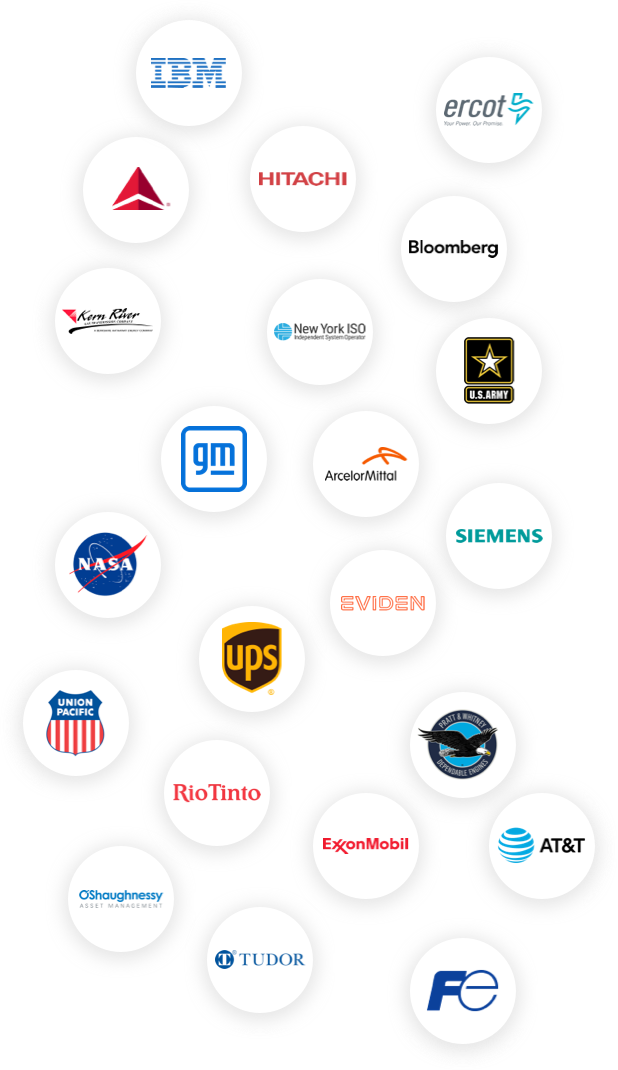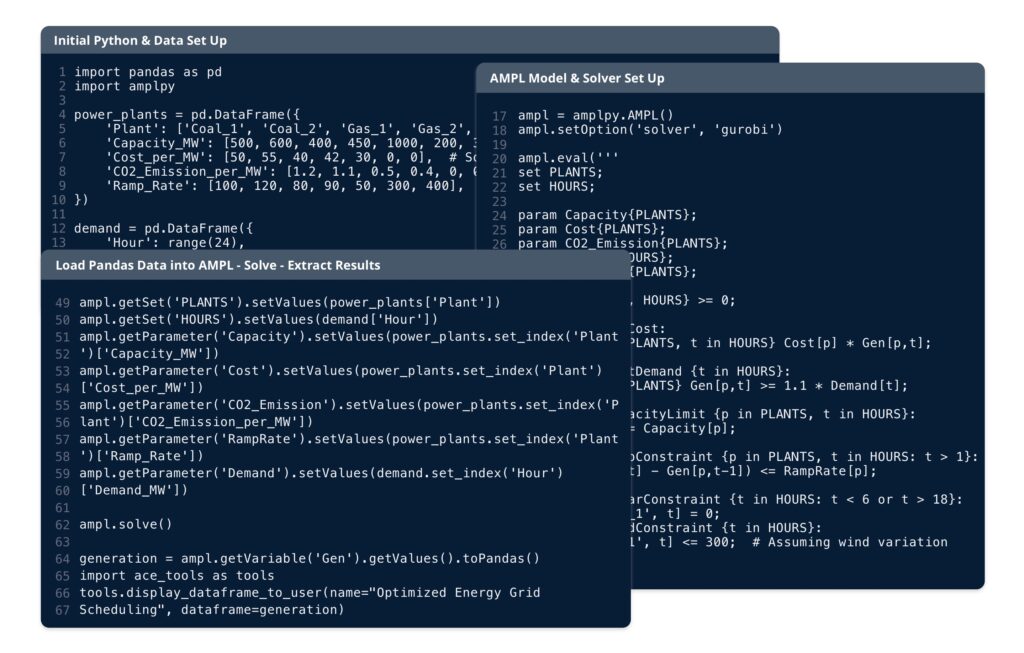If you’ve struggled with optimization in Python or OR-Tools, you’re not alone. AMPL gives you the modeling power of a domain-specific language—without leaving your Jupyter notebooks, Python scripts, or data pipelines.

Move beyond dashboards and forecasts—use optimization to make the best possible decisions based on real constraints, objectives, and tradeoffs.
Balance cost, risk, time, and resources in a way that spreadsheets and heuristics simply can't—across thousands of variables and scenarios.
Build optimization models that can grow with your data and your business logic, with architecture that supports maintainability and deployment.
Pair predictive models with prescriptive power—so you’re not just asking “What will happen?” but “What should we do about it?”
Many data teams start optimization projects with enthusiasm—only to hit complexity walls, technical bottlenecks, or code that becomes fragile and difficult to maintain. General-purpose tools like Python, R, or OR-Tools are powerful, but they weren’t designed to express complex decision models cleanly or scale them for production use.
Optimization logic often gets entangled with data processing or scripting code, making it brittle and hard to scale. Promising prototypes remain stuck in notebooks, never becoming reliable tools for decision-making.
Constraints that matter—regulations, budgets, timelines—are sometimes dropped just to make the model “work.” The result: cleaner code, but less accurate and actionable outputs.
When teams give up on optimization altogether, they leave behind the chance to automate, streamline, or improve decisions. In sectors like energy or finance, this can mean millions in lost value annually.
General-purpose languages are ideal for data exploration and machine learning, but they weren’t built for complex optimization modeling. When the tools don’t fit, it’s the strategy that suffers.
AMPL isn’t a general-purpose language with an optimization library—it’s a language created solely for optimization. That means your models are easier to build, easier to maintain, and powerful enough to reflect the real constraints and decisions that drive your business.
AMPL lets you describe complex systems using language that mirrors real-world logic—not low-level code. Your models stay readable and modular, even as they scale.
Instead of working around limitations, AMPL encourages you to include everything that matters—budgets, timelines, capacity, policies—right from the start.
By separating model logic from data and solver code, AMPL makes it easier to hand off models to developers, analysts, or stakeholders—without breaking everything.

With AMPL, you don’t need to sacrifice clarity to gain modeling power. You get both—built for optimization, from the ground up.

AMPL is used to model complex portfolio optimization, capital planning, and risk-constrained allocation strategies. Data teams build models that factor in returns, volatility, transaction costs, and regulatory rules—all with the ability to quickly adapt to market changes or evolving strategies.

From power generation to load balancing and renewables integration, AMPL supports large-scale optimization under real-world constraints. Data scientists use it for unit commitment, cost forecasting, dispatch planning, and grid optimization—especially when models need to reflect physical and policy limits.

AMPL powers routing, inventory, production, and capacity planning models for supply chains around the world. Analysts build systems that manage dynamic demand, transportation costs, lead times, and resource constraints—all while enabling real-time adjustments and scenario testing.

Data teams in this sector rely on AMPL to optimize crew scheduling, fleet assignment, ticket pricing, and turnaround logistics. AMPL handles multi-period, multi-constraint problems at scale—giving analysts the tools to build models that actually reflect operational realities.
Whether you need help debugging a model, choosing the right solver, or integrating AMPL into your infrastructure, we offer professional-grade support and consulting services tailored to your workflow. From one-off questions to long-term advisory, our team and partner network can help you move faster, with more confidence.

Step-by-step guides for integrating AMPL with pandas, NumPy, SciPy, and Jupyter Notebooks.
Access ready-to-use models for forecasting, portfolio optimization, supply chain planning, and more.
From Python APIs to ML integration, our documentation covers everything needed to get started.
Need help? Join our community of data scientists, analysts, and optimization experts for discussions and support.
AMPL complements Python, rather than replacing it. You can use AMPL to define and solve optimization models while leveraging pandas, NumPy, and SciPy for data preprocessing and visualization. The AMPL API for Python allows seamless interaction between Python scripts and AMPL models.
While Python libraries like PuLP and SciPy are great for small-scale problems, they often struggle with large, complex optimization tasks. AMPL provides:
Yes! AMPL can be used to optimize hyperparameters, feature selection, and predictive models. It integrates with machine learning frameworks like TensorFlow, PyTorch, and scikit-learn to enhance AI decision-making with constraint-based optimization.
Absolutely. You can run AMPL in Google Colab, use AMPL’s cloud deployment options, or integrate it with remote servers and APIs. This makes it easy to scale up from prototyping to production without hardware limitations.
AMPL is widely used in finance, supply chain, energy, healthcare, and logistics—essentially, any field that requires data-driven decision-making and large-scale optimization.
Try AMPL in your existing workflow. No setup, no commitment—just modeling power made for you.
Get in touch to book a time for us to talk about your specific needs, and demo real solutions.
From startups to Fortune 500s, explore how hundreds of businesses use AMPL to optimize complex problems.

Data analytics provides valuable insights, but without optimization, businesses are still left to manually determine the best course of action. Optimization bridges this gap by prescribing the best possible decisions based on real-world constraints, objectives, and business goals.
Analytics helps businesses understand patterns and trends, but optimization ensures they act on those insights with precision. Instead of relying on static reports, organizations can automate, refine, and scale decision-making through optimization.
Unlike predictive analytics, which forecasts future scenarios, optimization recommends the best course of action for any given situation. This ensures that companies maximize revenue, minimize costs, and allocate resources efficiently.
Retail businesses use demand forecasting to predict customer behavior, but optimization goes further by determining the ideal inventory levels and pricing strategies to maximize revenue. In finance, risk modeling helps identify financial uncertainties, yet optimization enables dynamic capital allocation to balance returns and risk exposure effectively. Similarly, in logistics, route analysis can highlight delivery trends, but only optimization can calculate the most efficient real-time routes to reduce costs and improve service.

Traditional business decisions often involve manual fine-tuning, trial and error, and reactive adjustments. Optimization eliminates guesswork by mathematically determining the most efficient allocation of resources, reducing unnecessary spending, and improving overall performance.
Instead of relying on static rules, reactive adjustments, and time-consuming manual processes, optimization proactively refines business operations in real time. By continuously analyzing constraints, trade-offs, and objectives, optimization ensures that businesses are always making the best possible decisions—without requiring constant oversight. Whether adjusting supply chain logistics, optimizing pricing strategies, or allocating resources, automated decision-making leads to better efficiency, reduced costs, and increased profitability.

Optimization removes inefficiencies across industries by transforming insights into precise, cost-saving actions. Instead of relying on fragmented analytics, businesses can integrate optimization to streamline supply chains, reduce operational waste, and improve financial decision-making. Whether it’s dynamically adjusting inventory, allocating capital more effectively, or optimizing production schedules, businesses can automate complex trade-offs to minimize costs while maximizing performance.

Optimization removes the need for manual trial and error and replaces it with data-driven decision-making.
Optimization models dynamically update based on real-time inputs, ensuring businesses stay ahead of changing conditions.
Automated optimization ensures the right people, products, and capital are allocated in the most cost-effective way—without constant oversight.
Optimization enables companies to scale decision-making without increasing complexity, ensuring profitability as they grow.
By fine-tuning complex processes, optimization reduces waste, labor costs, and inefficiencies across entire business operations.
As businesses grow, decision-making becomes increasingly complex. Optimization enables organizations to scale decision-making without adding complexity for analysts, stakeholders, or end users. Instead of relying on static models or manual adjustments, businesses can automate, refine, and scale decision-making processes—ensuring that every choice is backed by real-time data and advanced mathematical modeling.
Optimization ensures decisions remain fast, accurate, and adaptable as new data, constraints, and market conditions evolve. Whether optimizing financial portfolios, workforce planning, or supply chain logistics, businesses can make better, more scalable decisions without increasing workload or risk.

Unlike general-purpose programming languages like Python, R, or Java, AMPL is built specifically for optimization, allowing professionals to write models naturally and efficiently with minimal code overhead. This means faster development, fewer errors, and more focus on problem-solving rather than debugging syntax.
→ Example: A supply chain analyst can define an optimization model in dozens of lines instead of hundreds, accelerating development time.
AMPL connects directly to Python, Jupyter Notebooks, Pandas, SQL databases, and cloud environments, ensuring that optimization models fit seamlessly into existing analytics workflows without requiring major changes to infrastructure.
→ Example: A data scientist working in Python can call AMPL models directly, integrating optimization into machine learning and data-driven decision processes.
AMPL is solver-independent, allowing users to test and switch between leading commercial and open-source solvers without modifying their models. This ensures businesses can balance speed, accuracy, and cost-efficiency based on their needs.
→ Example: A financial analyst can evaluate Gurobi, CPLEX, or other solvers to optimize investment portfolios, selecting the best solver without rewriting their optimization models.
AMPL isn’t just a software tool—it’s a full-service optimization solution, offering consulting services for model development, solver tuning, and team training to ensure businesses get the best possible performance from their models.
→ Example: A manufacturing company can accelerate production planning optimization with AMPL’s expert consulting, ensuring they maximize efficiency while reducing costs.
Try AMPL in your existing workflow. No setup, no commitment—just modeling power made for you.
Get in touch to book a time for us to talk about your specific needs, and demo real solutions.
From startups to Fortune 500s, explore how hundreds of businesses use AMPL to optimize complex problems.